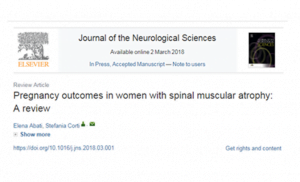 „Pregnancy outcomes in women with spinal muscular atrophy: A review” has been accepted for publication in the Journal of the Neurological Sciences. This work was supported in part by JPND through the DAMNDPATHS project, selected in the 2013 Cross-Disease Analysis call.
„Pregnancy outcomes in women with spinal muscular atrophy: A review” has been accepted for publication in the Journal of the Neurological Sciences. This work was supported in part by JPND through the DAMNDPATHS project, selected in the 2013 Cross-Disease Analysis call.
Author Archives: jpnd
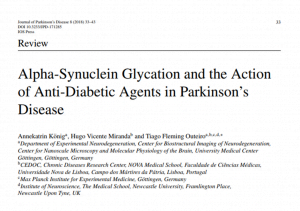 „Alpha-Synuclein Glycation and the Action of Anti-Diabetic Agents in Parkinson’s Disease” has been published in the Journal of Parkinson’s Disease. This work was supported in part by JPND through the aSynProtec project, selected in the 2015 JPco-fuND call.
„Alpha-Synuclein Glycation and the Action of Anti-Diabetic Agents in Parkinson’s Disease” has been published in the Journal of Parkinson’s Disease. This work was supported in part by JPND through the aSynProtec project, selected in the 2015 JPco-fuND call.
Researchers have found that disconnections of brain areas involved in attention and visual processing may contribute to visual hallucinations in individuals with Parkinson’s disease, according to a new study published online in the journal Radiology. The disconnected brain areas seen on functional MRI (fMRI) may be valuable in predicting the development of visual hallucinations in patients with Parkinson’s disease.
Studies using fMRI to investigate visual hallucinations in patients with Parkinson’s disease are rare and have been mainly limited to task-based methods using activities that involve visual stimulation or cognitive tasks. However, the authors note that the presence of visual hallucinations is strongly linked to the development of cognitive decline in patients with Parkinson’s disease. Cognitive deficits may influence a patient’s ability to perform specific tasks during an fMRI exam.
For this study, researchers used resting-state fMRI to examine the connectivity, or communication, between brain areas. The connectivity was measured in 15 patients with visual hallucinations, 40 patients without visual hallucinations, and 15 healthy controls by calculating the level of synchronization between activation patterns of different brain areas.
The results showed that in all the patients with Parkinson’s disease, multiple brain areas communicated less with the rest of the brain as compared to the control group. However, in patients suffering from visual hallucinations, several additional brain areas showed this decreased connectivity with the rest of the brain, especially those important in maintaining attention and processing of visual information.
While there are no direct therapeutic implications for patient care based on the research, the authors note that future studies could indicate whether techniques that could stimulate the areas with decreased connectivity could be helpful to treat visual hallucinations in people with Parkinson’s disease.
Paper: “Loss of Functional Connectivity in Patients with Parkinson Disease and Visual Hallucinations”
Reprinted from materials provided by the Radiological Society of North America.
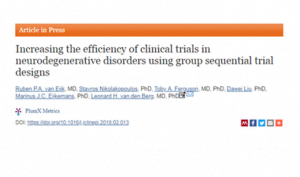 „Increasing the efficiency of clinical trials in neurodegenerative disorders using group sequential trial designs” has been accepted for publication in the Journal of Clinical Epidemiology. This work was supported in part by JPND through the SOPHIA project, selected in the 2011 biomarkers call, and the STRENGTH project, selected in the 2012 risk factors call.
„Increasing the efficiency of clinical trials in neurodegenerative disorders using group sequential trial designs” has been accepted for publication in the Journal of Clinical Epidemiology. This work was supported in part by JPND through the SOPHIA project, selected in the 2011 biomarkers call, and the STRENGTH project, selected in the 2012 risk factors call.
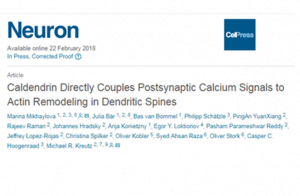 „Caldendrin Directly Couples Postsynaptic Calcium Signals to Actin Remodeling in Dendritic Spines” has been accepted for publication in Neuron. This work was supported in part by JPND through the STAD project, selected in the 2015 JPco-fuND call.
„Caldendrin Directly Couples Postsynaptic Calcium Signals to Actin Remodeling in Dendritic Spines” has been accepted for publication in Neuron. This work was supported in part by JPND through the STAD project, selected in the 2015 JPco-fuND call.
Researchers have discovered a new class of molecules in the brain that synchronize cell-to-cell communication and neuroinflammation/immune activity in response to injury or diseases. Elovanoids (ELVs) are bioactive chemical messengers made from omega-3 very long chain polyunsaturated fatty acids (VLC-PUFAs,n-3). They are released on demand when cells are damaged or stressed.
Working in neuronal cell cultures from the cerebral cortex and from the hippocampus and a model of ischemic stroke, the researchers found that elovanoids not only protected neuronal cells and promoted their survival, but helped maintain their integrity and stability. The work is published in Science Advances.
Although the occurrence of very long chain polyunsaturated fatty acids has been well documented, what has not been known is their significance and potential to be converted into biochemical triggers to resolve injury, inflammation and other threats to neuronal communication and cell survival.
The researchers discovered the structure and characteristics of two elovanoids – ELV-N32 and ELV-N34 – in the brain. Starting with neuron cell cultures and then an experimental model of stroke, they found that elovanoids were activated when cells underwent either oxygen/glucose deprivation or excitotoxicity – early events associated with stroke, epilepsy, Parkinson’s, traumatic brain injury and other neurodegenerative diseases. They determined the concentrations and therapeutic windows at which elovanoids conferred neuroprotection. The team found that elovanoids overcame the damaging effects and toxicity of these early events. In the stroke model, elovanoids reduced the size of the damaged brain area, initiated repair mechanisms and improved neurological/behavioral recovery.
Paper: “Elovanoids are a novel class of homeostatic lipid mediators that protect neural cell integrity upon injury”
Reprinted from materials provided by the Louisiana State University Health Sciences Center.
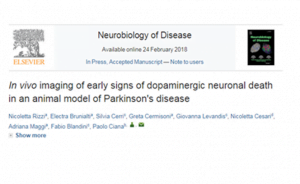 „In vivo imaging of early signs of dopaminergic neuronal death in an animal model of Parkinson’s disease” has been accepted for publication in Neurobiology of Disease. This work was supported in part by JPND through the GBA-PARK project, selected in the 2015 JPco–fuND call.
„In vivo imaging of early signs of dopaminergic neuronal death in an animal model of Parkinson’s disease” has been accepted for publication in Neurobiology of Disease. This work was supported in part by JPND through the GBA-PARK project, selected in the 2015 JPco–fuND call.
The first symptom of Parkinson’s disease is often an impaired sense of smell. This neurodegenerative disease primarily causes irreparable damage to nerve cells in a brain area involved in movement control. Until now, how it affects the olfactory system has been unclear. Researchers have now carried out a study comparing the olfactory bulbs of individuals with and without Parkinson’s disease. The researchers found that the total volume occupied by the functional units in the olfactory bulb — the so-called glomeruli — is in Parkinson’s cases only half of that in normal individuals. Moreover, the distribution of the glomeruli within the olfactory bulb is altered in Parkinson’s cases.
Nine out of ten patients with Parkinson’s disease suffer from defects of the sense of smell in the early stages of the disease — often years before the appearance of the motor symptoms that are characteristic of the disease. The motor symptoms are caused by a loss of nerve cells in the region of the substantia nigra in the brain that is responsible for controlling movement. What causes this cell death has not yet been fully clarified, but a key role appears to be played by Lewy bodies. These are inclusions, inside the cells, that contain a misfolded, defective version of the alpha-synuclein protein. Lewy bodies are found in the olfactory bulb before they appear in the substantia nigra.
The so-called olfactory vector hypothesis for Parkinson’s disease proposes that environmental factors, such as viruses, heavy metals or pesticides, are risk factors or even causes of the condition. No other sensory system than the olfactory system is in such close contact with the external environment — the inhaled air. The hypothesis posits that the disease-causing agent is introduced from the nasal cavity into the olfactory bulb, where Parkinson’s disease is triggered and gradually spreads through other parts of the brain.
The human olfactory bulb remains poorly studied. Research on this brain structure depends critically on the availability of pristine samples, which are typically procured post mortem, from brain donors. The precarious location of the olfactory bulb below the bulk of the brain and the many axons that connect it to the olfactory mucosa mean that special efforts must be made to protect the morphology of the olfactory bulb when collecting the samples.
The researchers were able to collect olfactory bulbs fit for an in-depth quantitative study. In a globe-spanning project, the researchers processed the post mortem olfactory bulbs chemically, cut ten-micrometer thin sections throughout its entire length, and stained the sections with fluorescently labeled antibodies. The labeled sections were then scanned, and the images reconstructed in 3D allowing for quantitative whole-olfactory bulb analyses.
As glomeruli of the human olfactory bulb are difficult to count unambiguously, the researchers came up with a new, quantitative parameter: the global glomerular voxel volume. Having defined this new parameter, the researchers compared the values between olfactory bulbs from normal and Parkinson’s disease cases, and found that it was reduced by more than half. Whether the decrease is the result of Parkinson’s disease cases having fewer or smaller glomeruli, or is due to a combination of these two effects, remains to be seen.
In addition, the distribution of the glomeruli was altered. The olfactory bulbs of normal cases had 70 percent of their glomerular component in the bottom half of the olfactory bulb, but the olfactory bulbs of Parkinson’s disease cases contained only 44 percent in the bottom half. The scientists also discovered that the greater the number of Lewy bodies with aggregated alpha synuclein, the smaller the glomerular component of the olfactory bulb.
The question now is which type of neurons in the olfactory bulb is affected first or foremost in Parkinson’s disease. Next, the researchers would like to identify the neurons in the olfactory bulb that are the most vulnerable.
Paper: “A ventral glomerular deficit in Parkinson’s disease revealed by whole olfactory bulb reconstruction”
Reprinted from materials provided by Max-Planck-Gesellschaft.
 „Does the community-based combined Meeting Center Support Programme (MCSP) make the pathway to day-care activities easier for people living with dementia? A comparison before and after implementation of MCSP in three European countries” has been published in International Psychogeriatrics. This work was supported by JPND through the MeetingDem project, selected in the 2012 healthcare evaluation call.
„Does the community-based combined Meeting Center Support Programme (MCSP) make the pathway to day-care activities easier for people living with dementia? A comparison before and after implementation of MCSP in three European countries” has been published in International Psychogeriatrics. This work was supported by JPND through the MeetingDem project, selected in the 2012 healthcare evaluation call.
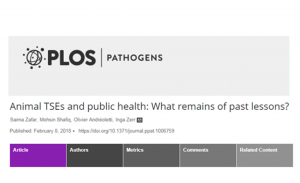 „Animal TSEs and public health: What remains of past lessons?” has been published in PLOS Pathogens. This work was supported in part by JPND through the DEMTEST project, selected in the 2011 biomarkers call.
„Animal TSEs and public health: What remains of past lessons?” has been published in PLOS Pathogens. This work was supported in part by JPND through the DEMTEST project, selected in the 2011 biomarkers call.
